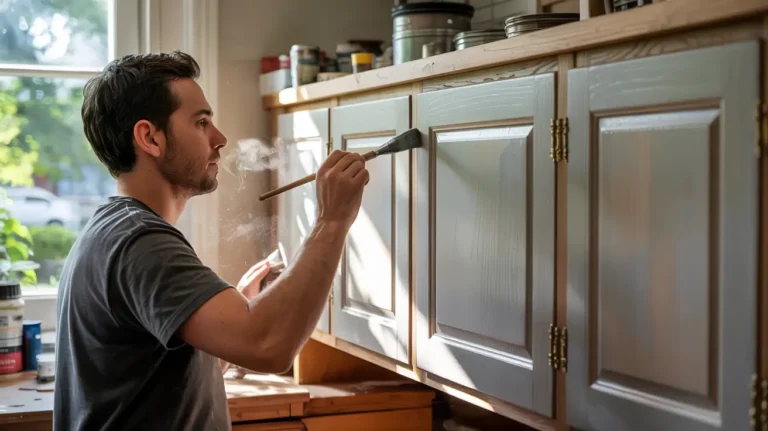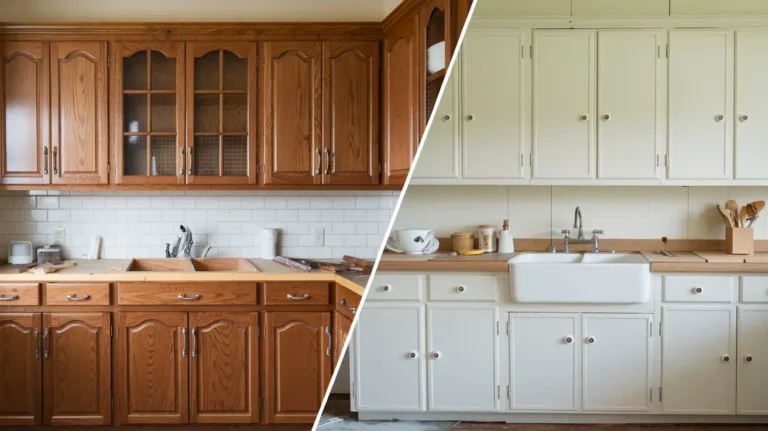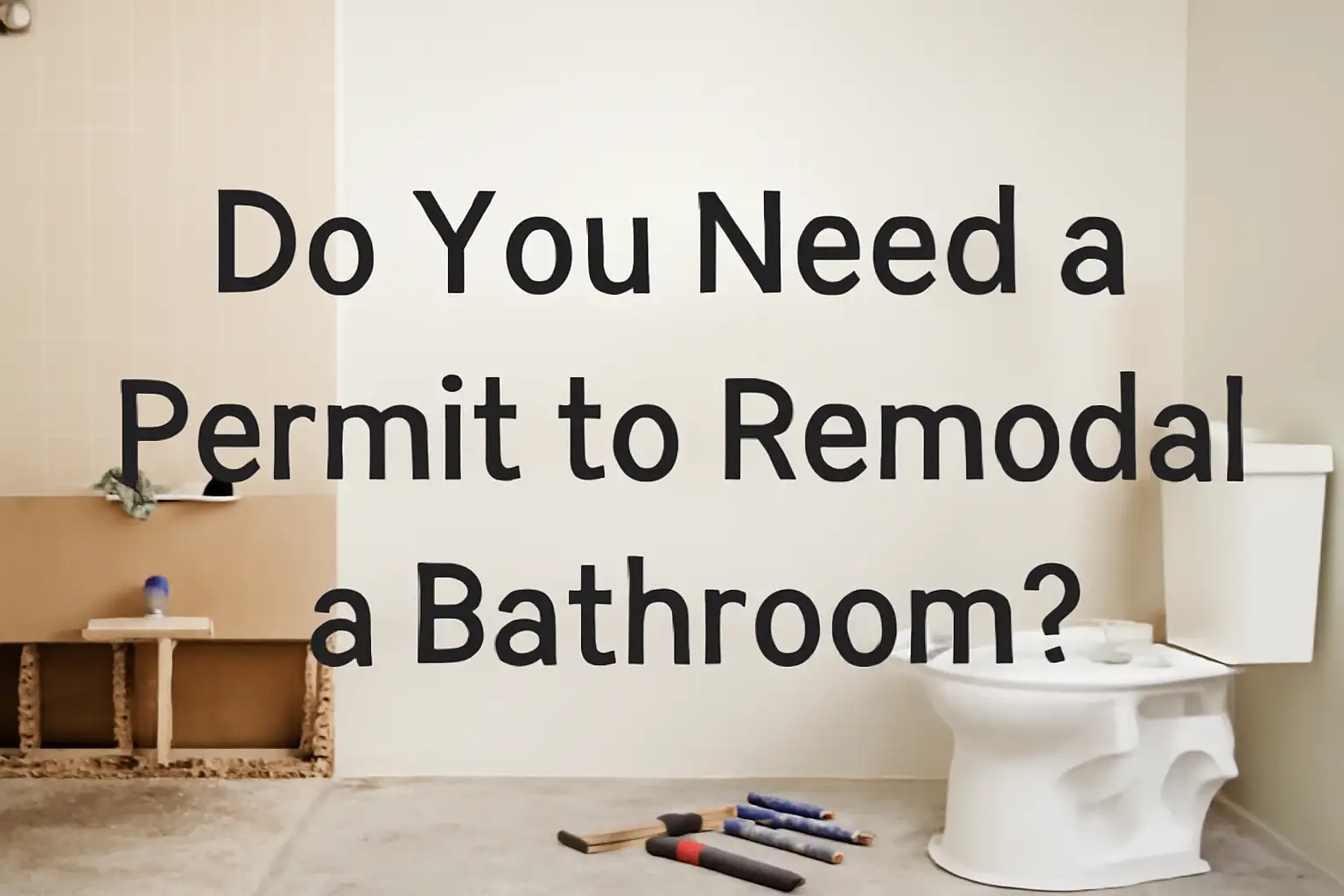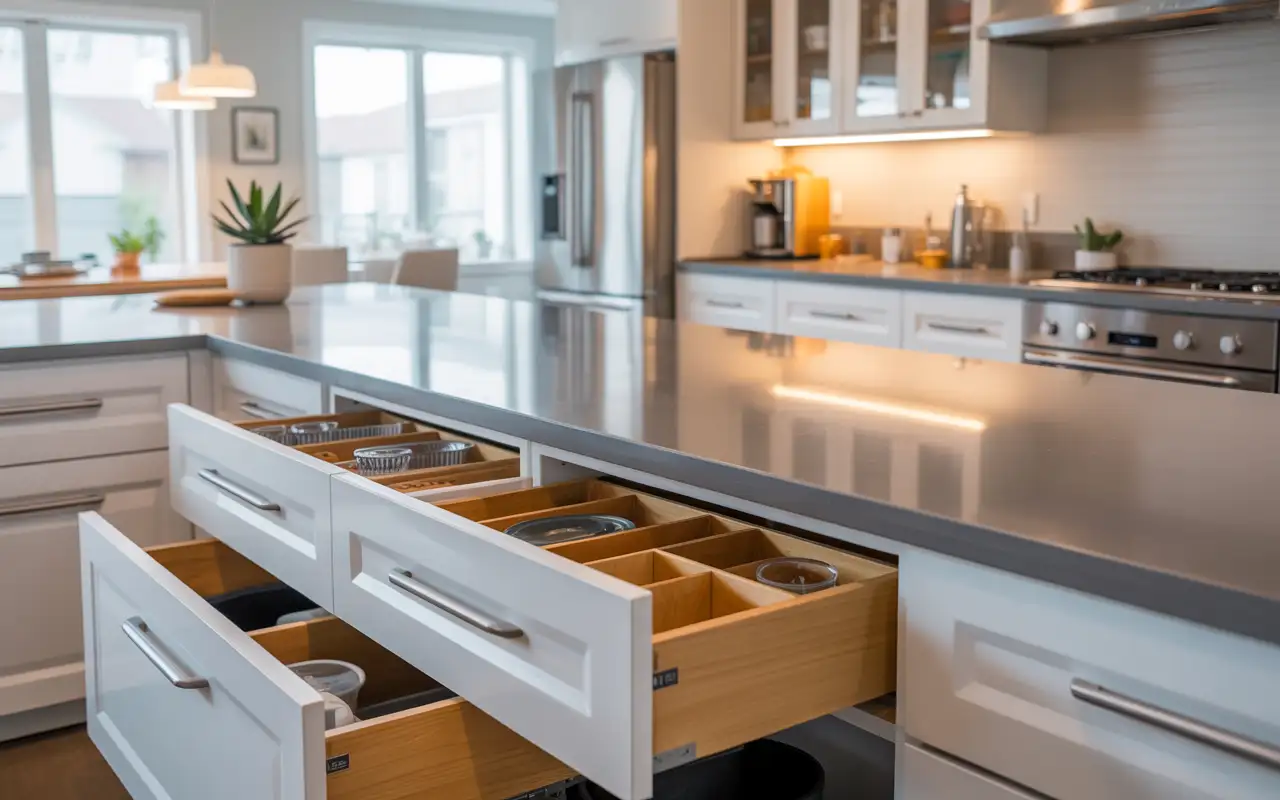You want a fresh kitchen look without the high cost of a full replacement. The biggest decision you face is choosing between cabinet refacing vs painting your existing cabinets. The direct answer is that cabinet refacing offers better durability and a long-term style change. Professional cabinet painting is the quickest refresh and the most cost effective choice.
Your final decision rests on your budget, the condition of your cabinet box, and how long you plan to stay in your home. We break down the professional process for both options. This will help you make a smart long term investment in your home.
Table of Contents
What Is Cabinet Refacing?

Cabinet refacing involves replacing your cabinet doors, drawer fronts, and hardware while keeping your existing cabinet boxes in place. Think of it as a complete exterior makeover for your kitchen without the mess and cost of full replacement.
The process leaves your kitchen layout exactly as it is. Your cabinet boxes stay put, but everything visible gets upgraded. New veneer covers the cabinet frames, new doors hang in place of the old ones, and fresh hardware completes the transformation.
This approach works best when your cabinet boxes are structurally sound but the style no longer fits your taste. We’ve completed over 200 cabinet projects in San Diego County since 2018, and refacing makes sense for about 60% of homeowners who contact us.
San Diego’s coastal climate actually makes refacing a smart choice. The marine layer and salt air can damage painted surfaces over time, but quality veneer materials stand up better to moisture. Homes within three miles of the coast see the biggest benefit from refacing over painting.
Average costs in San Diego for 2025:
- Small kitchen (10-12 linear feet): $3,200-$4,800
- Medium kitchen (15-20 linear feet): $5,200-$6,800
- Large kitchen (25+ linear feet): $7,200-$8,500
These prices include labor, materials, and new hardware. Add $800-$1,500 if you want soft-close hinges and premium handles.
Cabinet Refacing Process
The refacing process takes 3-5 days for most San Diego kitchens. Here’s exactly what happens:
Day 1: Assessment and Prep
A contractor measures your existing cabinets and checks the structural soundness of your cabinet boxes. Any water damage or loose joints get repaired before refacing begins. In San Diego, we often find moisture issues in homes near the coast that need fixing first.
Day 2: Removal
Old cabinet doors come off, along with drawer fronts and all hardware. The cabinet frames get thoroughly cleaned and degreased. Years of cooking oil and grime must come off completely for veneer to stick properly.
Day 3: Veneer Application
New veneer panels cover all visible cabinet frame surfaces. This step requires precision because any gaps or bubbles will show. Quality contractors use 3D laminate or wood veneer that matches your new doors perfectly.
Day 4-5: Installation
New cabinet doors and drawer fronts go on with fresh hinges. New hardware gets installed last. Everything gets adjusted so doors close flush and drawers glide smoothly.
The whole process creates minimal dust compared to a full replacement. You can usually cook dinner by day three, though contractors prefer you wait until everything is fully installed.
San Diego permits typically aren’t required for refacing since you’re not changing the structure. However, some HOAs in communities like Rancho Bernardo and Carmel Valley have design review requirements for exterior work if your kitchen is visible from the street.
Cabinet Refacing Options
You have several material choices when refacing your kitchen cabinets:
3D Laminate
The most popular choice in San Diego right now. This material uses high-resolution photography sealed under a protective clear coat to create realistic wood grain textures. It resists moisture better than real wood and costs 30-40% less. Perfect for coastal homes where humidity is a concern.
Real Wood Veneer
Maple, oak, and cherry veneers give you authentic wood grain at a fraction of the cost of solid wood doors. These work beautifully in Spanish-style homes common throughout San Diego neighborhoods like Mission Hills and North Park. The natural wood adds warmth that fits traditional architecture.
Thermofoil
A thin plastic coating bonded to MDF. This option is falling out of favor because it can peel in hot kitchens. San Diego summers get hot, and thermofoil doesn’t hold up as well as 3D laminate.
Rigid Thermofoil (RTF)
More durable than standard thermofoil. The material wraps around cabinet frames for a seamless look. It resists moisture well and costs less than wood veneer, making it a middle-ground option for budget-conscious homeowners.
You can also upgrade your kitchen cabinets with these extras:
- Glass inserts for upper cabinets ($150-$300 per door)
- Crown molding for a custom look ($200-$600)
- Pull-out shelves inside existing cabinet boxes ($100-$200 each)
- Under-cabinet lighting ($300-$800)
Pros and Cons of Cabinet Refacing
Metric | Pros of Cabinet Refacing | Cons of Cabinet Refacing |
Aesthetics | Complete style change (e.g., from outdated to modern). New door style and finish. | Cannot change the physical layout of your kitchen cabinet. |
Durability | High: Materials like HPL and 3D laminate are extremely long-lasting (15-20 years). | Higher upfront cost than painting kitchen cabinets. |
Customization | Excellent customization in door profiles and cabinet hardware. | If you have failing cabinets, the cost can approach refacing or replacement territory. |
Time | Less time-consuming installation than a full tear-out. Minimal disruption. | Requires a professional installer due to the precision of veneer application. |
Is Your Cabinet Box Healthy?
Before you decide on cabinet refacing vs painting, you must know if your underlying structures are sound. If your cabinets are failing, neither refacing nor painting is a suitable long term solution. A professional will assess these four points:
- Water Damage: If particle board or MDF boxes show signs of swelling, mold, or frame separation, you must opt for full replacement. Painting or refacing will only cover up a ticking time bomb.
- Structural Integrity: If shelves are sagging, drawer slides are mounted poorly, or the boxes wobble, the structure is compromised. Refacing does not fix structural issues.
- Functionality Needs: Do you need more storage or a completely different layout (e.g., adding an island or removing a pantry)? If so, refacing is not possible; you need to consider refacing or replacement.
- Drawer Slide Condition: If your existing drawer fronts and slides are worn out and require replacement, refacing easily addresses this. However, painting does not solve the failing drawer function.
If your boxes are sound and you like your layout, then you can confidently choose between painting and refacing.
What Is Cabinet Painting?

Cabinet painting updates your existing cabinets with new paint or stain while keeping the same doors, drawer fronts, and hardware. It’s the most budget-friendly way to transform your kitchen appearance.
This approach works when you like your current cabinet door style but want a color change. Many San Diego homes have solid wood cabinets with good bones that just need a fresh coat of paint to look modern again.
Professional cabinet painting differs completely from a DIY kitchen cabinet makeover. Proper surface preparation takes 60% of the project time. Skip the prep work and your paint will chip within a year. We see this constantly with DIY attempts that homeowners want us to fix.
The cost to paint kitchen cabinets in San Diego ranges from $1,800-$4,200 for an average kitchen. That includes:
- Small kitchen: $1,800-$2,400
- Medium kitchen: $2,600-$3,200
- Large kitchen: $3,400-$4,200
These prices assume hiring a professional cabinet painter. A DIY project costs $200-$500 in materials but requires 30-40 hours of your time and carries high risk of poor results.
California has strict VOC (Volatile Organic Compound) regulations for paint. The products available in San Diego contain lower solvents than other states, which means longer drying times but better air quality in your home.
Cabinet Painting Process
Professional cabinet painting follows a specific sequence:
Step 1: Complete Removal
Doors and drawer fronts come off. Hardware gets removed and labeled. Everything moves to a clean workspace for painting. Never paint cabinets while they’re still hanging in your kitchen.
Step 2: Deep Cleaning
TSP cleaner removes grease and cooking oil. San Diego kitchens collect a surprising amount of buildup, especially near the stove. This step is critical because paint won’t stick to greasy surfaces.
Step 3: Sanding
Light sanding creates texture for paint adhesion. Too much sanding removes detail on decorative doors. Too little and paint peels off. Professional painters know the right balance.
Step 4: Repairs
Gouges get filled with wood filler. Loose hinges get tightened. Any damage gets fixed before the primer goes on.
Step 5: Primer Application
High-quality bonding primer seals the wood and creates a base for paint. This step prevents tannin bleed-through that causes yellow stains on white painted cabinets.
Step 6: Multiple Coats of Paint
Two to three thin coats work better than one thick coat. Each layer needs 4-6 hours to dry in San Diego’s climate. Humidity near the coast can extend drying time to 8 hours per coat.
Step 7: Protective Topcoat
A clear polyurethane or conversion varnish protects the finish. This step is optional but highly recommended for long term durability. It adds $300-$500 to the cost but doubles how long the paint lasts.
Step 8: Reassembly
Everything goes back on with careful attention to alignment. Doors should hang level and close properly. New hardware often completes the updated look.
The whole process takes 5-7 days including drying time. San Diego’s mild weather means you can paint year-round without temperature issues that affect paint application.
Pros and Cons of Cabinet Painting
Metric | Pros of Cabinet Painting | Cons of Cabinet Painting |
Cost | Lowest initial cost. The most affordable way to upgrade your kitchen cabinets. | Requires regular touch-ups over time (every 5-7 years). Lower long-term durability. |
Design | Unlimited color palette. You can choose any shade to match your kitchen renovation. | Limited to the existing door style and profile of your kitchen cabinet. |
Time | Quickest process. Requires very little time compared to refacing. | Prep work is highly detailed and labor-intensive. |
Eco-Friendly | Creates no waste at all, making it the most eco-conscious choice since nothing is thrown away. | The finished look, while fresh, may not have the same perceived home value as new materials. |
Refacing vs. Painting Cabinets - What's the Difference?

When comparing painting cabinets vs refacing, the decision is about your priorities: budget, long-term wear, and desire for a style change.
Cost and Value Breakdown
Feature | Professional Painting | Cabinet Refacing |
Cost to Paint Kitchen Cabinets | $3,500 – $8,000 | $8,000 – $18,000 |
Project Lifespan | 5 – 7 Years (before necessary touch-up/repaint) | 15 – 20 Years |
Cost Per Year of Use | $500 – $1,600 (Highest long term cost) | $400 – $1,200 (Lower long term cost) |
Customization | Limited (Color change only) | High (New material, new door style, new functionality) |
Disruption | Very low | Low |
The cost of painting kitchen cabinets vs refacing is often misleading. While painting has a lower initial price, refacing is often the smarter long term cost effective option. You save on the long term maintenance of painted cabinets.
When to Choose Refacing:
- Your home value is $700,000 or higher
- You plan to stay in your home 10+ years
- You want a different door style
- Your cabinet doors are damaged or outdated
- You live near the San Diego coast
- Your kitchen gets heavy use
When to Choose Painting:
- Budget is your primary concern
- You like your current door style
- You’re preparing to sell within 5 years
- Your cabinet doors are in excellent condition
- You want a quick color refresh
- You’re comfortable with future maintenance
San Diego Climate Considerations
San Diego’s unique environment affects your decision between refacing or replacement and painting:
- Coastal Homes (Within 3 Miles of Ocean) Salt air accelerates paint deterioration. The marine layer creates constant moisture. Refacing with quality 3D laminate or wood veneer performs better long term. If you paint, budget for repainting every 5-7 years instead of 8-10.
- Inland Areas (East County, North County Inland) Less humidity means better paint performance. Summer heat reaches 90-100°F, which can affect thermofoil refacing materials. Standard paint and 3D laminate both work well here.
- Fog-Prone Areas (Coastal Bluffs, Clairemont) Constant morning fog creates moisture similar to coastal zones. Refacing or high-quality cabinet paint with protective topcoat recommended. Standard latex paint without sealer fails quickly.
Making Your Decision
Use this decision framework based on 200+ San Diego cabinet projects:
Choose Refacing If:
- You want new door styles (modern shaker, contemporary slab)
- Your current doors are damaged or warped
- You plan to stay 10+ years
- Home value justifies the investment ($700K+)
- You live in coastal areas with high humidity
- Budget allows $3,200-$8,500
Choose Painting If:
- You like your current cabinet door style
- Doors are in excellent structural condition
- Selling within 5 years
- Budget is tight ($1,800-$4,200 range)
- You want unlimited color options
- You’re okay with maintenance every few years
Skip Both and Replace If:
- Cabinet boxes have water damage
- You want layout changes
- Interior cabinet structure is failing
- You need more or fewer cabinets
- Budget allows $18,000-$35,000
The price to paint cabinets versus reface them shouldn’t be your only factor. Consider how long you’ll stay in your home, what your neighborhood comps show, and whether your current layout works for your needs.
Final Thoughts
Cabinet refacing vs painting both offer smart alternatives to full replacement. Refacing gives you a longer-lasting transformation with new doors and modern style options. Painting delivers budget-friendly color changes when your existing doors work fine.
For most San Diego homeowners, the decision comes down to timeline and budget. Staying in your home long term? Refacing pays off through durability and better coastal performance. Selling soon or working with limited funds? Professional painting provides excellent short-term value.
San Diego Home Remodeling has helped hundreds of homeowners transform their kitchens through both refacing and painting. Our team understands local climate challenges and can assess which option fits your specific situation. We’re licensed, insured, and have completed projects in every San Diego neighborhood from Carlsbad to Chula Vista.
Ready to upgrade your kitchen cabinets without the cost and hassle of full replacement? Our painting services in San Diego include professional cabinet painting with proper prep work and quality materials that last. Contact us for a free consultation and honest recommendation based on your goals and budget.
FAQs
Is it better to paint or reface cabinets?
It is better to reface cabinets if you want the longest durability (15-20 years) and the ability to change the actual style of your doors and drawer fronts. It is better to paint if your budget is tight and you only want a color change for the next 5-7 years. For the best return on investment (ROI) and longest lifespan, refacing is superior.
What is the average cost to paint kitchen cabinets?
The average cost to paint kitchen cabinets professionally in the San Diego area typically ranges from $3,500 to $8,000 for a standard-sized kitchen. This price includes high-quality, professional surface preparation, industrial primers, and durable 2K Polyurethane or lacquer topcoats. DIY efforts will reduce costs but will sacrifice long-term durability.
How much value does cabinet refacing add?
Refacing adds excellent home value because the final result is indistinguishable from brand-new cabinets to most buyers. Because the cost is 30% to 50% less than replacing your cabinet structure, the return on investment is extremely high. New door style and finish are highly attractive to potential buyers.
What is the downside of cabinet refacing?
The main downside is that cabinet refacing is a higher initial investment than painting. It also does not allow for structural changes. If your kitchen layout does not work for you, or your cabinet boxes are damaged, refacing won’t help.
Is Thermofoil or 3D laminate a good choice?
Yes. Modern 3D laminate (or Rigid Thermofoil) materials are highly durable, moisture-resistant, and low-maintenance. They are an excellent cost effective alternative to solid wood finishes, especially in the high-use kitchen environment.







